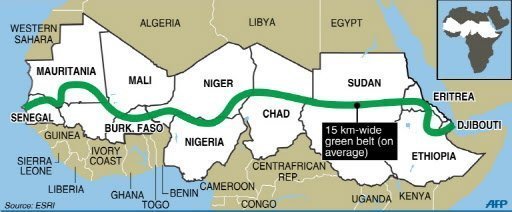World leaders and heads of major international agencies on Wednesday in Paris at the ongoing UN climate change conference (COP21) pledged $4 billion over the next five years to step up implementation of the Great Green Wall for the Sahara and Sahel Initiative (GGWSSI).

Over the next 10 years, more than 50 million hectares of land will be restored, which will help sequester an estimated 250 million tons of carbon. The metaphoric Great Green Wall will provide sustainable alternatives for millions of young people considering migrating from poverty-stricken areas in Africa’s Sahel region.
Leaders expressed hope that the renewed commitment to the GGWSSI – Africa’s largest rural development project – will create new opportunities for communities’ right across the Sahel, whilst establishing greater resilience against climate change long into the future.
The Great Green Wall – originally launched in 2007 – is taking root in Africa’s Sahel region, one of the world’s most vulnerable areas to climatic variability.
Macky Sall, President of Senegal, said his country has already “planted 12 million trees and restored 25,000 ha of degraded land. This has helped boost long-term food, energy, water and economic security.”
President Sall was speaking Tuesday morning, at the Global Summit of the Heads of State and Government that are GGWSSI member states. The Summit was hosted by France’s President François Holland in parallel to the Climate Change Conference taking place in Paris, France.
The Ministerial meeting held Wednesday morning with heads of development partners was the follow-up to the Summit, with the renewed commitments coming from the Government of France, African Development Bank, Global Environment Facility, World Bank, and European Union, as well as the African leaders.
The changes to Lake Chad, which borders five countries in West Africa and serves a large population in the region, including two million people who benefit directly, signals the depth of the crises.
In just 30 years it has shrunk by nearly 10 times its original size from 25,000km2 to 2,500 km2. During this period, demand for water and arable land soared as the population around the lake rose from 22 million in 1991 to 38 million in 2012. The population is expected to reach 50 million by 2020.
The disappearance of Lake Chad is a security crisis that is fueling terrorist groups like Boko Haram, said President Idriss Déby of Chad. He called for effective commitment on the ground to counter these threats.
Persistent drought and land degradation in the Sahel are robbing land-dependent families of their livelihoods. Poverty, conflict over depleting natural resources, and increasingly, mass migration to Europe are rife. More than 20 million people in the Sahel are currently food insecure, according to the UN Office for Humanitarian Affairs.
The Wall is a practical response taken by countries located along the southern margins of the Sahara Desert. “Ensuring vulnerable communities are resilient to climate change is our first line of defence against the growing challenges of forced migration, food insecurity, civil conflict and extremism. The constraints countries face demand that we take early and effective action in Africa and other regions of the world where people rely heavily on the land for survival,” commented Ms Monique Barbut, the UN’s top advisor on controlling the loss of productive land.
“I commend the renewed commitment by the partners to the Great Green Wall, but hasten to add that it is in the interest of all countries to invest in land restoration. We can reduce the impact of future climate-induced disasters and quickly cut back the excess carbon dioxide emissions in the race to stay below a 2 degree Celsius target,” Ms Barbut added.
A virtual reality film of the Wall, produced by the UN Convention to Combat Desertification together with global brand studio, Venture Three, was shown at the Africa Pavilion at COP21. The film titled, Growing a World Wonder, follows Binta, a young Senegalese girl, as she and her family tend to their section of the Wall. It explores the challenges they face and how the project is already transforming their lives for the better.
“There are many world wonders, but the Great Green Wall will be unique and everyone can be a part of its history,” says Dr. Dlamini Zuma, Chairperson, African Union Commission. “Together, we can change the future of African communities in the Sahel.”
The Great Green Wall is African-led project with an ambition to restore the productivity of degraded lands across the Sahel region and transform millions of lives. Its goal is to provide food, jobs and a future for the millions of people who live in a region on the frontline of climate change. The Great Green Wall brings together African countries and international partners, under the leadership the African Union Commission, which includes the World Bank, Global Environment Facility, the UN Convention to Combat Desertification, the Food and Agriculture Organisation, and the European Commission, amongst others.
